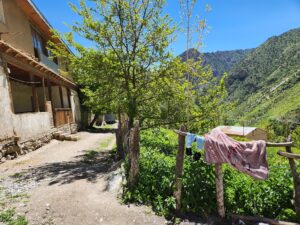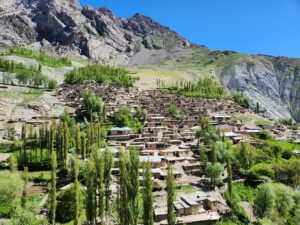
| Location: Voru Village, Fann Mountains, Tajikistan Distance: 6 miles (out and back) Peak Elevation: 7,202′ Elevation Gain: 1,497′ Trip Length: 3 hours Difficulty: Moderate |
Wander next to a babbling brook and silver poplars. Visit the ancient village of Voru in a remote canyon in the Fann Mountains of Tajikistan. The Sogdians built stunning terraced homes on the mountainside two millennia ago.
Village at the Top of the Canyon | Sogdians | Village Architecture | Village Life | Video Tour
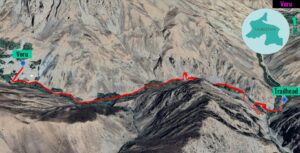
Directions
| Trailhead: The trailhead is about three miles south of the village of Ghazza. Head west on the road. 3 miles: The road ends at the base of Voru village. Return to the trailhead. |
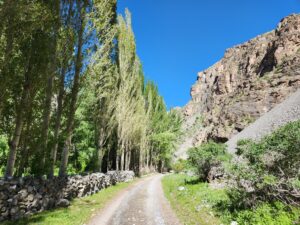
Village at the Top of the Canyon
After starting at a bridge, we follow a rising trail by a stream to the end of a canyon. The path passes farms, homes, and small wooden bridges. There are short stone walls bordering the plots of land. Farmers work the land row by row. Tall silver poplar trees provide soothing intermittent shade. Brown mountain slopes rise above each side of the green farms. Children and women walk by and wave. Men and boys ride or lead donkeys carrying sacks.
Voru is a village on a mountain slope. Three little toddlers run down a steep hill path while waving and saying hello. We try to speak with not much luck. The village elder, who also speaks French, greets us at the base of the village and shows us around.
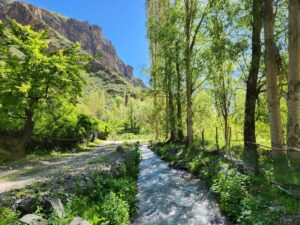
Sogdians
The Sogdians are an Iranian people who have inhabited the village since the 6th century BC. Sogdian merchants traveled as far west as the Byzantine Empire and lived in China. They originally followed Zoroastrianism until the Muslim conquest and helped spread Buddhism. The Sogdians built city-states from one oasis to another and controlled trade across the multiple Silk Roads. They influenced fashions, entertainment, arts, lifestyles, technologies, and religious ideas wherever they traveled.

Village Architecture
Voru means open face and the homes are arranged in cascading steps. They are stacked on top of each other where the rooftop of one is the floor of another. The packed clay homes resemble little apartment buildings with steep little paths curving around the homes. The villagers hold important celebrations on the largest rooftop.
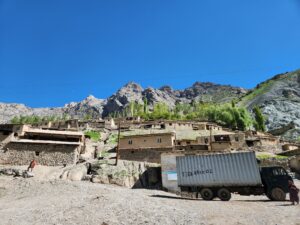
We walk to the steam where women are hand washing garments. We go down a muddy path and cross the bridge. Then we scramble up the gravelly path for a panoramic viewpoint of the village from the opposite hillside.
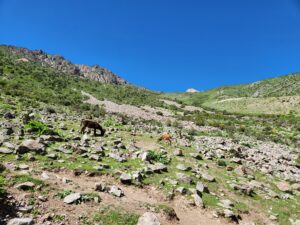
Village Life
We climb back up to the village and enter a small blacksmith shop. We each take a turn at hammering some iron on the anvil. At a shaded terrace, we sit on a carpet, where we enjoy tea and coffee with cookies. There is a bowl of kefir, which is cold and tangy. After walking back down, we hop into the vans to a lunch spot in the middle of some trees.
